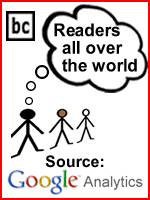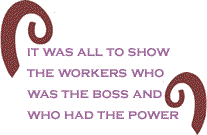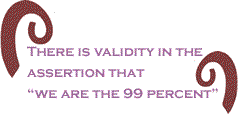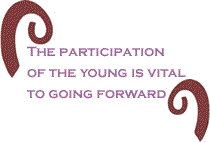It
has been three decades since Ronald Reagan broke the 11,500-member
Professional Air Traffic Controllers Organization (PATCO),
and the relationship between capital and labor in America,
always a nervous circling of adversaries at best, has
never been the same.
 In
firing the controllers, jailing its leaders, and blacklisting
every member from ever working for the federal government
again, Reagan opened the floodgates for a renewed assault
on unionized workers and their unions that had not been
seen since corporations hired gun thugs and �detective�
agencies that were little more than private armies that
paid little attention to the laws of the land.
In
firing the controllers, jailing its leaders, and blacklisting
every member from ever working for the federal government
again, Reagan opened the floodgates for a renewed assault
on unionized workers and their unions that had not been
seen since corporations hired gun thugs and �detective�
agencies that were little more than private armies that
paid little attention to the laws of the land.
PATCO
and its leadership could be faulted for many things, but
they could not be faulted for taking the action that American
workers had taken for generations: when working conditions
became intolerable and negotiations seemed to be at a
dead end, they went on strike. It�s just that they were
little prepared for a strike, either internally, or in
terms of their relationships with the rest of organized
labor. They just didn�t know how the other union would
respond to their strike. There was little or no preparation,
because they believed that the other unions would honor
their picket lines and the shutdown of airports across
the nation would bring the administration back to the
bargaining table.
They
could not have been more wrong. There already were decades
of legal and tactical efforts by Corporate America that
kept unions from exercising solidarity with one another,
therefore, there were few other unions that respected
the PATCO picket lines, at least at the outset. Later
in the strike, other unions traveled from the West Coast
across the continent through Canada
on that country�s airlines, for example, to go by train
from Montreal to Washington,
D.C., to attend the organized labor�s Solidarity Day in September,
1981. Hundreds of thousands of trade unionists and their
supporters from across the country attended the speeches
and rally on the National Mall and PATCO was assured a
place on the program.
The
Right Wing and Corporate America tried to make the controllers�
issue one of wages and benefits, but one of the most important
issues was the safety of the flying public and the controllers,
themselves.  The
stress in the airport towers was taking its toll, since
there were more airplanes than there should have been
at any given time and the controllers had to sort out
all of that and make sure the planes and their passengers
landed safely.
The
stress in the airport towers was taking its toll, since
there were more airplanes than there should have been
at any given time and the controllers had to sort out
all of that and make sure the planes and their passengers
landed safely.
PATCO
was one of only three unions that had endorsed Ronald
Reagan for president. The other was the International
Brotherhood of Teamsters, at the time, the nation�s largest
union. The controllers endorsed Reagan and supported him
and had the assurance that he would take seriously the
safety problems that plagued both the workers and airline
safety, in general.
Candidate
Reagan in October, 1980, wrote to Robert Poli, PATCO president,
during the presidential campaign of his concern about
the safety of the flying public: �You can rest assured
that, if I am elected president, I will take whatever
steps are necessary to provide our air traffic controllers
with the most modern equipment available and to adjust
staff levels and work days so that they are commensurate
with achieving a maximum degree of public safety.� With
an assurance like that, the union�s leadership thought
he would be receptive to their requests after he won the
election and was in the White House.
Again,
they were wrong. They could not get a hearing. The stress
in the towers mounted, the danger mounted, and the controllers
took the step that resulted in the demise of their union
and the end of their work in the towers. In the early
stages of the strike, the image that was imprinted on
the minds of workers was that of Poli in chains, being
taken to jail. It was an image out of some authoritarian
regime, not the U.S.A. But, it was Reagan�s America, where a
union leader was not only jailed, but the members were
blacklisted from ever working for the federal government
again. That meant some long-time controllers who were
close to retirement never would be able to finish their
remaining year or two, to get their full pension.

Reagan
was showing his Right Wing base how tough he was. He fulfilled
the decades-long dream of the rulers of the economic universe:
the U.S. Chamber of Commerce, the National Association
of Manufacturers, the Business Roundtable, and others.
They fought for years to curb the potential strength of
American workers through the forming of unions and bargaining
for their share of the nation�s benefits.
The
new president had discovered a way to break the power
of the workers by rendering their strikes a weakness,
rather than strength through unity. For decades, since
the era of Franklin D. Roosevelt, the strike that could
bring the wheels of commerce to a halt was something that
the captains of industry feared, even though they were
the most powerful force in the political and economic
realm. But the law said that workers could strike without
the fear of being fired, especially if they struck over
an unfair labor practice or a health or safety issue.
But,
Reagan fired them and permanently replaced them with a
workforce that eventually formed a union, the National
Air Traffic Controllers Association (NATCA). The new union
did not have to be told that they were not allowed to
strike, since their own constitution contained a no-strike
clause. The controllers were tamed.
It
took no time at all for corporations all over the U.S.
to emulate Reagan. When there wasn�t a strike, they would
provoke one, and then �permanently replace� the strikers.
 Since
they weren�t �fired,� it was deemed to be legal, though
it was a distinction without a difference. The permanently
replaced workers were still without jobs and a means of
support, as good as being fired. An entire �industry�
was built on corporations creating a �union-free environment,�
nearly as soon as it became clear that PATCO would not
be able to get the jobs back for its members.
Since
they weren�t �fired,� it was deemed to be legal, though
it was a distinction without a difference. The permanently
replaced workers were still without jobs and a means of
support, as good as being fired. An entire �industry�
was built on corporations creating a �union-free environment,�
nearly as soon as it became clear that PATCO would not
be able to get the jobs back for its members.
Law
firms that specialized in �union prevention� in non-union
shops, or in breaking unions where they existed, sprang
up in virtually every city. Companies were willing to
spend millions to buy union-busting consultants, rather
than spend a few hundred thousand dollars to negotiate
a contract with workers, who would spend that money in
short order, right in their own communities. It was a
waste and engendered animosities between labor and capital
that continue to this day, and it was all to show the
workers who was the boss and who had the power.
A
majority of the American people, most of whom were, and
are workers, backed Reagan�s tough strut against the unions.
According to a Gallup poll of the time (1981), 59 percent of Americans polled agreed
with Reagan�s handling of the strike, while 30 percent
disapproved and 11 percent had no opinion. It was a rollback
of the raising of the living standard that American workers
had achieved during the 35 years since World War II. And,
it was the beginning of a downward slide, not only for
workers in general, but also for all of the American people
and the nation�s economy.
The
Reagan-led attack against workers should have been a warning
to the workers of the next few generations, but we have
reached 2012 and the attacks against wageworkers and their
families continue relentlessly.  It
is no accident of fate that Republican governors and a
few Democrats in several states have attacked the contracts,
the pay, and the benefits of public workers, thus the
living standards, of millions of families, under the guise
of �closing state budget gaps.�
It
is no accident of fate that Republican governors and a
few Democrats in several states have attacked the contracts,
the pay, and the benefits of public workers, thus the
living standards, of millions of families, under the guise
of �closing state budget gaps.�
One
indicator of the strength of unions, especially in the
private sector, is the number of strikes, and strikes
have dwindled to just a few each year. In just the past
decade, and especially in the past few years, the attack
on public workers has played out in states like Wisconsin,
where Governor Scott Walker has tried to kill off government
workers� unions by trying to take away their collective
bargaining rights. He and those who have presided over
the demise of the U.S.
economy want American workers back to collective begging.
Wisconsinites are fighting back and the Walker
recall petition is expected to result in a recall election
sometime this year.
The
great American electorate seems to be waking up, but it�s
a slow process. That�s why the Occupy Wall Street movement
has had such wide support. It is because the fight is
being taken to the right place. It isn�t Washington
and Congress, the judiciary, and the White House that
hold the key to evening out the economy. It�s Wall Street,
the people who call the shots in both the economy and
in the political system.
The
lessons of PATCO and Reagan went unheeded, and that�s
what brought us to the condition we are in today. What
was needed 31 years ago was solidarity among all American
unions. There is validity in the assertion that �we are
the 99 percent.� The �1 percent� has grown fat at the
expense of working people, the young, the old, and the
sick. Perhaps, the unions and their leaders have learned
the lesson of PATCO, but their support of the Occupy movement
has been tepid, at best.

They
have said that the youth have to step up to ensure that
all of the people make progress. Every leader in every
sector, in every kind of organization has said that the
participation of the young is vital to going forward.
At a time when black unemployment is twice that of the
whole country; and unemployment among other groups, such
as among Native Americans, is three or four times that;
at a time when people are not getting the medical care
they need; when the children are not being educated well
(except the progeny of the 1 percent); when people are
not being housed decently; and when control of our food
is concentrated among very few giant corporations, we
need the unity of the 99 percent, and we need the young
men and women in politics, the economy, and in all cultural
work.
 In
short, the American people need the solidarity that we
learned we needed all those years ago, when Ronald Reagan
broke a union, sent its members to the street with no
means of supporting their families, and opened the floodgates
of an assault on all workers.
In
short, the American people need the solidarity that we
learned we needed all those years ago, when Ronald Reagan
broke a union, sent its members to the street with no
means of supporting their families, and opened the floodgates
of an assault on all workers.
Three
decades ago, we were tested and we came up short. That
should not be allowed to happen again.
 BlackCommentator.com
Columnist, John Funiciello, is a labor organizer and former
union organizer. His union work started when he became
a local president of The Newspaper Guild in the early
1970s. He was a reporter for 14 years for newspapers in
New York State. In
addition to labor work, he is organizing family farmers
as they struggle to stay on the land under enormous pressure
from factory food producers and land developers. Click
here
to contact Mr. Funiciello.
BlackCommentator.com
Columnist, John Funiciello, is a labor organizer and former
union organizer. His union work started when he became
a local president of The Newspaper Guild in the early
1970s. He was a reporter for 14 years for newspapers in
New York State. In
addition to labor work, he is organizing family farmers
as they struggle to stay on the land under enormous pressure
from factory food producers and land developers. Click
here
to contact Mr. Funiciello.

